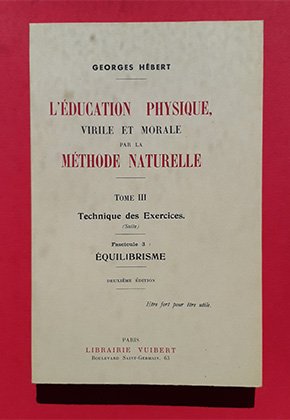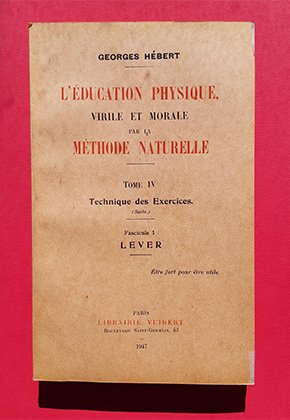Many tests have been the subject of the establishment of a rating table according to the principle seen on the page “force-Measurement of force”. They were established after the study on thousands of subjects.
The tables for the age group 18 to 35 are presented here as an example. The other tables can be found in the book “Code de la force” by Georges Hébert.
⎪ Walking ⎪ Race ⎪ Quadruped ⎪ To climb ⎪
⎪ Jump ⎪ Lift ⎪ Throw ⎪ Swimming ⎪
Walking |
 The conditions of execution:
The conditions of execution:
Walking on flat ground,
For speed steps, at all times one foot must be in contact with the ground, and during the double support, it must be clear.
Consult the tables
Women’s events
Men’s events
Race
|
 The conditions of execution:
The conditions of execution:
Shopping is done with spikeless shoes or barefoot.
Consult the tables
Women’s eventss
Men’s events
Quadruped |
 The test is run either in ordinary running on the 4 limbs (trot or gallop mode), or by leaps (alternating leaps from the feet to the hands and vice versa).
The test is run either in ordinary running on the 4 limbs (trot or gallop mode), or by leaps (alternating leaps from the feet to the hands and vice versa).
The ground is firm, non-elastic (packed earth, non-mossy grass, etc.) in order to test the resistance of the wrists, and secondarily of the shoulders, to the repeated shocks of the progression in support.
Consult the tables
Women’s events
Men’s events
To climb |

The conditions of execution:
Climbing the rope:
The tests are carried out on a smooth rope.
They are done without the help of the legs for the ascent, for the descent the legs can be used.
Pull-ups with foot support:
Lying flat on your back, hang from two neighboring smooth ropes or from a bar of good height, the body simply lifted off the ground and completely stretched out, the heels maintaining support on the ground. In this position, pull on the arms and bring the chin to the height of the hands. Pause, then lower the body by fully extending the arms but without touching the ground other than with the heels.
Repeat the exercise for a maximum of one minute. This test will allow people who are unable to perform a pull-up to be able to evaluate themselves.
Repulsions with foot support: (“pumps”)
Place yourself in a stretched support position, on your feet and hands, your body lying down, your feet together. In this position, lower the body to the ground, without touching it by bending the ras, pause, then raise the body by fully extending the arms, without the knees helping the ascent.
Repeat the exercise for a maximum of one minute.
Pull-ups without foot support:
Hang from a bar, arms fully extended, legs dangling, hands shoulder-width apart, fingers pointing forward. Pull on the arms and bring the chin to the height of the birth of the fingers. Pause, then lower your body by fully extending your arms. Repeat the exercise for a maximum of one minute. Note: the arms must be fully extended and the shoulders relaxed before each new pull; there should not be a first pull of the shoulders before a pull on the arms.
Repulsions without foot support:
Place yourself in stretched support on two parallel bars, feet off the ground; lower the body fully by bending the arms, pause and raise the body by fully extending the arms and without the legs helping in this ascent in any way;
Repeat the exercise for a maximum of one minute.
Consult the tables
Women’s events
Men’s events
Jump |
 For all the jumps, 3 attempts are made. The best performance is selected.
For all the jumps, 3 attempts are made. The best performance is selected.
The fallout must be on the ground, which may be loose (sand), and on the feet only; (Jumps with landing on the
back, on a mattress have no utilitarian value; they just measure trigger performance).
High jumps are done over a bar placed on cleats in order to be able to fall or a stretched rubber band.
The crossing takes place either from the front or from the side.
For long jumps, the run-up and fall ground must be level and flat.
High jump without momentum:
Feet are together or apart; but when rising it is forbidden to jump, take a call or stomp.
In addition, they must leave the ground at the same time and not one after the other. They can be performed from the front (in this case, there must be no twisting of the body when crossing) or from the side: in this case it is the average of the best jump on the left and the best jump on the right which gives performance.
Standing long jump:
If the feet are bare, the toes can butt over the vertical projection of the edge constituting the starting line, to avoid
slide. Same for the high jump.
High jump with momentum:
Face jump: The run-up must take place on a line perpendicular to the line to be crossed; The take-off can be done on one foot or both at the same time. In the first case, it is the average right and left take-off foot that gives the performance.
Side jump:
Again, it is the average of the best left jump and the best right jump that gives the performance.
Long jump with momentum:
The run-up must be 20 meters long and take place on a line perpendicular to the line to be crossed; The take-off can be done on one foot or both at the same time. In the first case, it is the average right and left take-off foot that gives the
performance. Again, it is the average right and left take-off foot that gives the performance.
Consult the tables
Women’s events
Men’s events
LiftLift
Lift
r |

Heavy lifting:
The test consists of lifting with both hands, arms stretched above the head, the heaviest possible weight, using the relaxation of the legs as desired. The rise can be done by thrown, developed or snatch.
Raise in resistance:
The test consists of lifting a weight the greatest number of times for a maximum of two minutes. Once the weight is raised at arm’s length, bring it back down and make it touch the ground very briefly, before the line of the heels;
Consult the tables
Women’s events
Men’s events
Throw |

Throwing a heavy weight by shoulder throw:
The throw is executed with one arm, knowing that it is the average of the best throw of the right arm and the left arm which will give the performance.
The momentum is caught in a circle of 1m radius and the thrower must not leave it before the fall of the weight, fall which must be done in a band 2m wide.
Skill throw of a light weight (ball, stone, etc.) by relaxing the arm:
The throw is made on a target of 1m² (1x1m) whose lower edge is 50 cm from the ground located 20 meters away.
It is done by a sudden movement of lateral relaxation of the arm (and not by a swing from bottom to top).
12 throws are made from each arm.
Distance throw of a light weight (1 kg) by swinging the arm:
The roll can be done:
- By swinging the arm back and forth, the body facing the direction of the launch (gesture of the ball thrower),
- By lateral swing of an arm rising above the head, the body turned to the right or to the left of the direction of the launch (gesture of the grenade launcher),
- By horizontal swing of one arm, the body turned to the right or to the left (gesture of the discus thrower).
Here again it is the average best thrown right arm and left arm which gives the performance of the heels;
Consult the tables
Women’s events
Men’s events
Swimming |
 Swimming test:
Swimming test:
The start is made 1 meter from the surface of the water by a free dive. The swimming mode is free.
Diving underwater:
The start is also 1 meter from the surface of the water; the time is counted from the moment the body is fully immersed and stops as soon as a part emerges.
The swimmer must swim underwater or stay balanced as desired but without clinging to anything.
High dive:
The body must enter the water headfirst.
Consult the tables
Women’s events
Men’s events

















